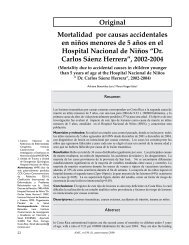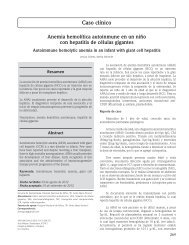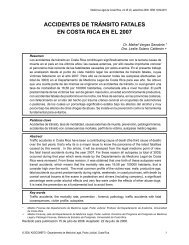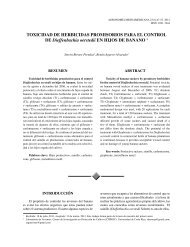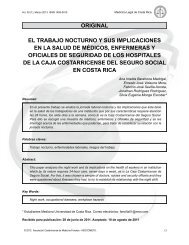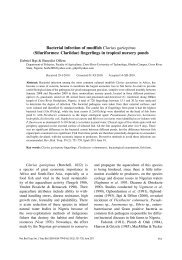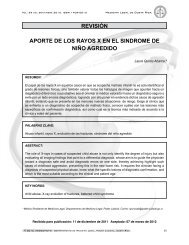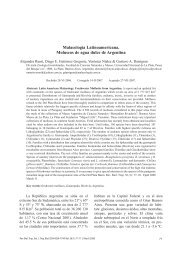Fatty acids in an estuarine mangrove ecosystem - SciELO
Fatty acids in an estuarine mangrove ecosystem - SciELO
Fatty acids in an estuarine mangrove ecosystem - SciELO
You also want an ePaper? Increase the reach of your titles
YUMPU automatically turns print PDFs into web optimized ePapers that Google loves.
<strong>Fatty</strong> <strong>acids</strong> <strong>in</strong> <strong>an</strong> estuar<strong>in</strong>e m<strong>an</strong>grove <strong>ecosystem</strong><br />
Nabeel M. Alikunhi 1 , Rajendr<strong>an</strong> Naray<strong>an</strong>asamy 1 & Kathires<strong>an</strong> K<strong>an</strong>dasamy 1<br />
1. Centre of Adv<strong>an</strong>ced Study <strong>in</strong> Mar<strong>in</strong>e Biology, Annamalai University, Par<strong>an</strong>gipettai, 608 502, Tamil Nadu, India;<br />
kathirsum@rediffmail.com<br />
Received 19-V-2009. Corrected 06-I-2010. Accepted 02-II-2010.<br />
Abstract: <strong>Fatty</strong> <strong>acids</strong> have been successfully used to trace the tr<strong>an</strong>sfer of org<strong>an</strong>ic matter <strong>in</strong> coastal <strong>an</strong>d estuar<strong>in</strong>e<br />
food webs. To del<strong>in</strong>eate these web connections, fatty acid profiles were <strong>an</strong>alyzed <strong>in</strong> species of microbes<br />
(Azotobacter v<strong>in</strong>el<strong>an</strong>dii, <strong>an</strong>d Lactobacillus xylosus), prawns (Metapenaeus monoceros <strong>an</strong>d Macrobrachium<br />
rosenbergii) <strong>an</strong>d f<strong>in</strong>fish (Mugil cephalus), that are associated with decompos<strong>in</strong>g leaves of two m<strong>an</strong>grove<br />
species, Rhizophora apiculata <strong>an</strong>d Avicennia mar<strong>in</strong>a. The fatty <strong>acids</strong>, except long cha<strong>in</strong> fatty <strong>acids</strong>, exhibit<br />
ch<strong>an</strong>ges dur<strong>in</strong>g decomposition of m<strong>an</strong>grove leaves with a reduction of saturated fatty <strong>acids</strong> <strong>an</strong>d <strong>an</strong> <strong>in</strong>crease of<br />
monounsaturated fatty <strong>acids</strong>. The br<strong>an</strong>ched fatty <strong>acids</strong> are absent <strong>in</strong> undecomposed m<strong>an</strong>grove leaves, but present<br />
signific<strong>an</strong>tly <strong>in</strong> the decomposed leaves <strong>an</strong>d <strong>in</strong> prawns <strong>an</strong>d f<strong>in</strong>fish, represent<strong>in</strong>g <strong>an</strong> import<strong>an</strong>t source for them.<br />
This revealed that the microbes are dom<strong>in</strong><strong>an</strong>t producers that contribute signific<strong>an</strong>tly to the fishes <strong>an</strong>d prawns<br />
<strong>in</strong> the m<strong>an</strong>grove <strong>ecosystem</strong>. This work has proved the fatty acid biomarkers as <strong>an</strong> effective tool for identify<strong>in</strong>g<br />
the trophic <strong>in</strong>teractions among dom<strong>in</strong><strong>an</strong>t producers <strong>an</strong>d consumers <strong>in</strong> this m<strong>an</strong>grove. Rev. Biol. Trop. 58 (2):<br />
577-587. Epub 2010 June 02.<br />
Key words: m<strong>an</strong>groves, fish, microbes, fatty acid, biomarker.<br />
M<strong>an</strong>groves are one among the most productive<br />
<strong>ecosystem</strong>s <strong>an</strong>d their productivity is<br />
attributed to litter degradation <strong>an</strong>d efficient<br />
recycl<strong>in</strong>g of nutrients, which are supplied by<br />
both autochthonous <strong>an</strong>d allochthonous <strong>in</strong>puts<br />
from natural <strong>an</strong>d <strong>an</strong>thropogenic sources (Heald<br />
1971, Odum & Heald 1975, Lee 1990, Kathires<strong>an</strong><br />
& B<strong>in</strong>gham 2001). Microbial process<strong>in</strong>g of<br />
litter is <strong>an</strong> import<strong>an</strong>t mech<strong>an</strong>ism for preserv<strong>in</strong>g<br />
nutrients <strong>an</strong>d energy <strong>in</strong> the m<strong>an</strong>grove <strong>ecosystem</strong><br />
(Fell et al. 1975, Fell & Master 1981, Raghukumar<br />
et al. 1994, Kathires<strong>an</strong> & B<strong>in</strong>gham 2001,<br />
Rajendr<strong>an</strong> & Kathires<strong>an</strong> 2007). M<strong>an</strong>grove litter<br />
of low nutritive value is decomposed <strong>an</strong>d converted<br />
<strong>in</strong>to nutrient-rich which serves as food<br />
for fishes (Odum 1971, Lee 1990, Kathires<strong>an</strong><br />
& B<strong>in</strong>gham 2001, Rajendr<strong>an</strong> & Kathires<strong>an</strong><br />
1998, 1999a, 2000, 2004 & 2007, Ashton et<br />
al. 1999). The litter decomposition occurs<br />
typically <strong>in</strong> three, often-simult<strong>an</strong>eous phases:<br />
(i) leach<strong>in</strong>g of soluble components; (ii) microbial<br />
oxidation of refractory components such<br />
as cellulose <strong>an</strong>d lign<strong>in</strong>; <strong>an</strong>d (iii) physical <strong>an</strong>d<br />
biological fragmentation with microbial enrichment<br />
(Valiela et al. 1985). In these processes,<br />
the flow of carbon <strong>an</strong>d nitrogen from primary<br />
producers to consumers takes place, but the<br />
flow is not clearly understood for the m<strong>an</strong>grove<br />
<strong>ecosystem</strong>.<br />
Food web <strong>in</strong> m<strong>an</strong>groves is often under<br />
debate <strong>an</strong>d contribution of the m<strong>an</strong>groves as<br />
primary producers is much clear even when<br />
adv<strong>an</strong>ced techniques like stable isotopes have<br />
been used (C<strong>an</strong>uel et al. 1995, Bouillon et<br />
al. 2002). <strong>Fatty</strong> acid trophic marker (FATM)<br />
concept is based on the observation that mar<strong>in</strong>e<br />
primary producers lay down certa<strong>in</strong> fatty acid<br />
patterns that may be tr<strong>an</strong>sferred conservatively<br />
to primary consumers (Dalsgaard et al. 2003).<br />
<strong>Fatty</strong> <strong>acids</strong> c<strong>an</strong> be specific to each species <strong>an</strong>d<br />
Rev. Biol. Trop. (Int. J. Trop. Biol. ISSN-0034-7744) Vol. 58 (2): 577-587, June 2010<br />
577
are often used as food web markers (Kiyashko<br />
et al. 1998, Kharlamenko et al. 2001, Dalsgaard<br />
et al. 2003). This FATM concept has<br />
been successfully used to trace the tr<strong>an</strong>sfer of<br />
org<strong>an</strong>ic matter <strong>in</strong> coastal <strong>an</strong>d estuar<strong>in</strong>e food<br />
webs (Kharlamenko et al.1995, Napolit<strong>an</strong>o et<br />
al.1997, Mezi<strong>an</strong>e & Tsuchiya 2000, Bachock et<br />
al. 2003, Hall et al. 2006). However, such studies<br />
are not available for estuar<strong>in</strong>e m<strong>an</strong>grove<br />
<strong>ecosystem</strong>s <strong>an</strong>d associated flora <strong>an</strong>d fauna of<br />
India. To fill this lacuna, the present study was<br />
made to trace the potential of fatty <strong>acids</strong> as<br />
biomarkers <strong>in</strong> identify<strong>in</strong>g the trophic <strong>in</strong>teractions,<br />
<strong>in</strong> such a way to del<strong>in</strong>eate the food web<br />
<strong>in</strong> m<strong>an</strong>grove <strong>ecosystem</strong>.<br />
MATERIALS AND METHODS<br />
Experimental work: The present study was<br />
conducted from J<strong>an</strong>uary to March 2007, post<br />
monsoon season of the study area. Senescent<br />
leaves of Rhizophora apiculata Blume <strong>an</strong>d<br />
Avicennia mar<strong>in</strong>a (Forsk). Vier were collected<br />
from a m<strong>an</strong>grove forest, grow<strong>in</strong>g along the Vellar<br />
estuary (11º29’11’’ N-9º46’17’’ E) located<br />
<strong>in</strong> southeast coast of India. The leaves were<br />
shade-dried <strong>an</strong>d packed at 50g <strong>in</strong> each of six<br />
nylon bags (15x10cm) <strong>an</strong>d mesh size of 2mm.<br />
Pits were constructed l<strong>in</strong>early <strong>in</strong> the <strong>in</strong>ter-tidal<br />
m<strong>an</strong>grove area with <strong>an</strong> equi-dist<strong>an</strong>ce of 1m <strong>an</strong>d<br />
a dimension of 1x1x1m. The temperature dur<strong>in</strong>g<br />
the study period varied between 29°C <strong>an</strong>d<br />
34°C. The bags conta<strong>in</strong><strong>in</strong>g the leaves of three<br />
different species were submerged separately <strong>in</strong><br />
each pit <strong>an</strong>d one pit was kept as control (without<br />
<strong>an</strong>y m<strong>an</strong>grove leaves). Three replicates for<br />
all the groups of pits were also ma<strong>in</strong>ta<strong>in</strong>ed.<br />
Each bag was submerged <strong>in</strong> water by plac<strong>in</strong>g<br />
a stone weigh<strong>in</strong>g 0.25kg <strong>in</strong>side the bag. The<br />
<strong>in</strong>ner side of each pit was covered with nylon<br />
net of 2mm mesh size to trap the juvenile<br />
fishes. This experiment was conducted for 70<br />
days. Fishes attracted towards the litter bags<br />
were collected daily dur<strong>in</strong>g the time of low tide<br />
by lift<strong>in</strong>g the <strong>in</strong>ner net.<br />
Collection <strong>an</strong>d process<strong>in</strong>g of microbes:<br />
For microbial <strong>an</strong>alysis, the decompos<strong>in</strong>g leaf<br />
samples were taken r<strong>an</strong>domly from each nylon<br />
bag dur<strong>in</strong>g 0, 20, 30, 40, 50, 60 <strong>an</strong>d 70 days of<br />
experiment. They were cut <strong>in</strong> to small pieces<br />
<strong>an</strong>d were washed thoroughly <strong>in</strong> sterilized seawater<br />
<strong>in</strong> order to remove debris on the leaves.<br />
For enumeration of total colony form<strong>in</strong>g units,<br />
the Zobell’s mar<strong>in</strong>e agar medium was used<br />
for total heterotrophic bacteria (THB) <strong>an</strong>d<br />
the W<strong>in</strong>ogradsky’s medium for azotobacters.<br />
All the media components were purchased<br />
from Hi-media Chemicals, Mumbai, India. The<br />
microbes were enumerated by adopt<strong>in</strong>g spread<br />
plate method. The plates were <strong>in</strong>cubated <strong>in</strong> <strong>an</strong><br />
<strong>in</strong>verted position at 28±2°C. All the determ<strong>in</strong>ations<br />
were carried out <strong>in</strong> triplicates. After the<br />
<strong>in</strong>cubation period of 2 to 3 days for THB <strong>an</strong>d 7<br />
to 10 days for azotobacters, the colonies were<br />
counted <strong>an</strong>d calculated for colony form<strong>in</strong>g<br />
units per gram leaf tissue. The dom<strong>in</strong><strong>an</strong>t microbial<br />
colonies were identified based on morphological<br />
<strong>an</strong>d biochemical characters (Buch<strong>an</strong><strong>an</strong><br />
& Gibbons 1974).<br />
Collection <strong>an</strong>d process<strong>in</strong>g of prawns, f<strong>in</strong>fish<br />
<strong>an</strong>d m<strong>an</strong>grove leaves: The collected samples<br />
of prawns, f<strong>in</strong>fish <strong>an</strong>d m<strong>an</strong>grove leaves<br />
were brought to laboratory <strong>an</strong>d washed <strong>in</strong><br />
the tap water. The prawns <strong>an</strong>d f<strong>in</strong>fish were<br />
identified us<strong>in</strong>g st<strong>an</strong>dard guidel<strong>in</strong>es (Fischer<br />
& Bi<strong>an</strong>chi 1984, Paulp<strong>an</strong>di<strong>an</strong> & Ramasamy<br />
1991) <strong>an</strong>d were used for further studies.<br />
Analysis of fatty <strong>acids</strong>: <strong>Fatty</strong> acid profile<br />
was <strong>an</strong>alyzed for the m<strong>an</strong>grove leaves of<br />
R. apiculata <strong>an</strong>d A. mar<strong>in</strong>a at different days<br />
of decomposition, <strong>an</strong>d also for the dom<strong>in</strong><strong>an</strong>t<br />
species of microbes <strong>an</strong>d prawns <strong>an</strong>d f<strong>in</strong>fish<br />
(muscles) associated with the decompos<strong>in</strong>g<br />
m<strong>an</strong>grove leaves. <strong>Fatty</strong> <strong>acids</strong> were extracted<br />
by st<strong>an</strong>dard methods (Bligh & Dyer 1959,<br />
Mezi<strong>an</strong>e & Tsuchiya 2000). The extracts were<br />
saponified at 80°C for 90m<strong>in</strong> with a mixture of<br />
sodium hydroxide <strong>an</strong>d meth<strong>an</strong>ol <strong>in</strong> a ratio of<br />
1:2. The fatty acid methyl ester (FAME) was<br />
prepared <strong>an</strong>d <strong>an</strong>alyzed by us<strong>in</strong>g a gas chromatograph<br />
(Agilent-GC 6890N) equipped with<br />
flame ionization detector. Capillary column HP<br />
Ultra 2 with 2m long <strong>an</strong>d 0.2mm <strong>in</strong>ner diameter,<br />
coated with 5% phenyl methyl silax<strong>an</strong>e<br />
<strong>an</strong>d 0.33µm thicknesses was used. The rate of<br />
hydrogen carrier gas flow was ma<strong>in</strong>ta<strong>in</strong>ed at<br />
578 Rev. Biol. Trop. (Int. J. Trop. Biol. ISSN-0034-7744) Vol. 58 (2): 577-587, June 2010
30ml/m<strong>in</strong>. Most of the FAME were identified<br />
by us<strong>in</strong>g a calibration st<strong>an</strong>dard software of<br />
MIDI. Some of FAME peaks were identified<br />
by compar<strong>in</strong>g their retention times with those<br />
of authentic st<strong>an</strong>dards (Supelco Inc.).<br />
Statistical <strong>an</strong>alysis: To evaluate signific<strong>an</strong>ce<br />
<strong>in</strong> fatty acid composition, one way<br />
ANOVA test followed by Post hoc test was<br />
used with the help of SPSS, Version 13.0<br />
(SPSS, Ill<strong>in</strong>ois).<br />
RESULTS<br />
Fish <strong>an</strong>d microbial counts: The trends <strong>in</strong><br />
fishes <strong>an</strong>d microbial counts with decompos<strong>in</strong>g<br />
m<strong>an</strong>grove leaves are depicted <strong>in</strong> the Fig. 1 <strong>an</strong>d<br />
2. In general, fish groups <strong>in</strong>creased towards<br />
decompos<strong>in</strong>g leaves up to 40 days, <strong>an</strong>d then<br />
decl<strong>in</strong>ed (Fig. 1). A similar trend was also<br />
recorded with counts of total heterotrophic<br />
bacteria <strong>an</strong>d azotobacters (Fig. 2). The prawns,<br />
f<strong>in</strong>fish <strong>an</strong>d microbes behaved similarly with<br />
<strong>in</strong>creas<strong>in</strong>g days of leaf decomposition up to 40<br />
days <strong>in</strong> both species of m<strong>an</strong>groves, R. apiculata<br />
<strong>an</strong>d A. mar<strong>in</strong>a.<br />
Dom<strong>in</strong><strong>an</strong>t species attracted towards the<br />
decompos<strong>in</strong>g leaves were Metapenaeus monoceros,<br />
Macrobrchium rosenbergii, <strong>an</strong>d Mugil<br />
cephalus that belong respectively to penaeid<br />
prawns, non-penaeid prawns <strong>an</strong>d f<strong>in</strong>fish. Two<br />
predom<strong>in</strong><strong>an</strong>t species of microbes isolated from<br />
the decompos<strong>in</strong>g m<strong>an</strong>grove leaves were Azotobacter<br />
v<strong>in</strong>el<strong>an</strong>dii <strong>an</strong>d Lactobacillus xylosus.<br />
Ch<strong>an</strong>ges of fatty acid groups dur<strong>in</strong>g<br />
decomposition of m<strong>an</strong>grove leaves: Levels of<br />
fatty acid groups <strong>in</strong> the m<strong>an</strong>grove leaves of<br />
R. apiculata <strong>an</strong>d A. mar<strong>in</strong>a at 0, 40 <strong>an</strong>d 70<br />
days of decomposition are shown <strong>in</strong> table 1.<br />
Fig. 1. Abund<strong>an</strong>ce of penaeids, non-penaeids <strong>an</strong>d f<strong>in</strong>fish at different days of leaf decomposition <strong>in</strong> two species of m<strong>an</strong>groves<br />
(A) Rhizophora apiculata; <strong>an</strong>d (B) Avicennia mar<strong>in</strong>a.<br />
Rev. Biol. Trop. (Int. J. Trop. Biol. ISSN-0034-7744) Vol. 58 (2): 577-587, June 2010<br />
579
Fig. 2. Total heterotrophic bacteria (THB) <strong>an</strong>d azotobacters at different days of leaf decomposition <strong>in</strong> two species of<br />
m<strong>an</strong>groves (A) Rhizophora apiculata; <strong>an</strong>d (B) Avicennia mar<strong>in</strong>a, expressed <strong>in</strong> colony form<strong>in</strong>g units per gram leaf tissue.<br />
<strong>Fatty</strong> acid groups varied signific<strong>an</strong>tly (p
TABLE 1<br />
Percent composition of fatty acid classes <strong>in</strong> decomposed leaves of two m<strong>an</strong>grove species, Rhizophora apiculata <strong>an</strong>d Avicennia mar<strong>in</strong>a, predom<strong>in</strong><strong>an</strong>t microbes, penaeids, nonpenaeids<br />
<strong>an</strong>d f<strong>in</strong>fish species. Values are me<strong>an</strong> of three samples with st<strong>an</strong>dard deviation<br />
(SAFAs–Saturated fatty <strong>acids</strong>, MUFAs–Monounsaturated fatty <strong>acids</strong>, BrFAs–Br<strong>an</strong>ched fatty <strong>acids</strong>, PUFAs–Polyunsaturated fatty <strong>acids</strong>, LCFAs–Long cha<strong>in</strong> fatty <strong>acids</strong>)<br />
Class of<br />
fatty <strong>acids</strong><br />
Days of decomposed leaves of<br />
Rhizophora apiculata<br />
Days of decomposed leaves of<br />
Avicennia mar<strong>in</strong>a<br />
0 40 70 0 40 70<br />
Content of fatty <strong>acids</strong> (% of total fatty <strong>acids</strong>)<br />
SAFA<br />
Microbial species associated with<br />
decompos<strong>in</strong>g leaves<br />
Lactobacillus<br />
xylosus<br />
Azotobacter<br />
v<strong>in</strong>el<strong>an</strong>dii<br />
Prawn <strong>an</strong>d fish species associated with<br />
decompos<strong>in</strong>g leaves<br />
Metapenaeus<br />
monoceros<br />
Macrobrachium<br />
rosenbergii<br />
Mugil<br />
cephalus<br />
14:00 2.8±0.8 a 3.1±0.9 a 2.2±0.6 a 2.9±0.8 a 1.7±0.4 b 1.2±0.3 b 1.5±0.3 b 1.4±0.3 b 1.2±0.2 b 0.5±0.1 c 1.2±0.2 b<br />
15:00 4.6±1.6 a 3.2±1.0 b 3.5±0.8 b 3.5±0.8 b 2.6±0.5 c 2.2±0.5 c 0.5±0.1 d 0.8±0.2 d 0.4±0.1 d 0.7±0.2 d 0.5±0.1 d<br />
16:00 40.7±6.8 a 35.6±6.1 a 26.4±5.3 b 40.4±6.7 a 39.2±6.2 a 34.4±6.1 c 24.5±5.1 b 28.4±5.4 b 17.8±4.7 d 19.1±4.9 d 15.5±4.1 d<br />
17:00 7.5±2.1 a 2.9±0.8 b 1.5±0.3 b 4.7±0.9 c 3.6±0.8 c 0.5±0.1 d 1.8±0.3 b 3.9±0.8 c 0.2±0.09 d 0.4±0.1 d 0.2±0.9 d<br />
18:00 4.1±1.2 a 2.2±0.6 b 2.4±0.5 b 7.6±1.9 c 2.5±0.5 b 2.3±0.5 a 4.5±0.9 a 2.1±0.4 b 2.9±0.6 b 4.7±1.2 a 4.6±1.1 a<br />
19:00 3.9±0.9 a 1.8±0.5 b 1.1±0.2 b 4.6±1.1 a 1.9±0.4 b 1.1±0.2 b 0 1.2±0.3 b 1.3±0.3 b 0.9±0.2 b 1.2±0.3 b<br />
20:00 4.5±1.2 a 2.2±0.4 b 2.7±0.6 b 2.5±0.4 b 2.3±0.4 b 2.1±0.3 b 0 0 1.2±0.2 c 0.5±0.1 d 0.2±0.08 d<br />
Total SAFA 68±9.1 a 51.5±6.2 b 40.8±5.4 c 67.5±8.4 a 53.4±7.1 b 43.2±5.6 c 33.5±4.8 d 38.4±5.1 c 25.6±3.6 e 27.3±3.7 e 24.4±3.5 e<br />
MUFA<br />
14.1 2.2±0.6 a 4.9±1.2 b 10.2±2.4 c 1.5±0.2 a 3.5±0.8 b 0.5±0.1 d 0.7±0.1 d 1.1±0.1 d 3.5±0.8 b 4.7±0.9 b 1.5±0.2 d<br />
16:1n7 2.2±0.6 a 6.1±1.9 b 9.8±2.1 c 1.1±0.1 d 5.9±1.3 b 0.1±0.07 e 0.9±0.2 d 1.8±0.3 a 3.3±0.8 f 3.1±0.8 f 2.9±0.7 f<br />
18:1n7 0 0 0 0 0 0 10.41±1.9 a 6.98±1.5 b 5.7±1.4 b 4.5±1.1 b 6.7±1.5 b<br />
18:1n9 0 0 0 0 0 0 2.9±0.5 a 3.1±0.6 a 1.4±0.2 b 2.3±0.3 a 1.7±0.3 b<br />
20:1n7 1.7±0.4 a 5.9±1.8 b 10.5±2.4 c 2.3±0.2 a 4.7±1.1 b 0.3±0.09 d 0 0 1.2±0.2 a 4.5±1.1 b 1.2±0.2 a<br />
Total<br />
MUFA<br />
5.9±0.4 a 17.4±2.1 b 29.3±3.8 c 4.8±0.5 a 14.2±1.6 b 27.8±2.4 c 14.5±2.5 b 12.4±2.1 b 14.8±2.7 b 18.5±3.1 d 12.9±2.3 b<br />
BrFA<br />
14:ISO 0 0.3±0.09 a 0.4±0.1 a 0 1.4±0.2 b 0.7±0.1 a 0.5±0.1 a 0.4±0.1 a 0.8±0.1 a 0.6±0.1 a 11.5±2.6 c<br />
15:ISO 0 2.6±0.7 a 1.6±0.3 b 0 1.7±0.3 b 2.4±0.5 a 12.1±2.7 c 14.7±2.9 c 10.5±2.5 c 9.1±2.1 c 2.9±0.5 a<br />
Rev. Biol. Trop. (Int. J. Trop. Biol. ISSN-0034-7744) Vol. 58 (2): 577-587, June 2010<br />
581
TABLE 1 (Cont<strong>in</strong>ued)<br />
Percent composition of fatty acid classes <strong>in</strong> decomposed leaves of two m<strong>an</strong>grove species, Rhizophora apiculata <strong>an</strong>d Avicennia mar<strong>in</strong>a, predom<strong>in</strong><strong>an</strong>t microbes, penaeids, nonpenaeids<br />
<strong>an</strong>d f<strong>in</strong>fish species. Values are me<strong>an</strong> of three samples with st<strong>an</strong>dard deviation<br />
(SAFAs–Saturated fatty <strong>acids</strong>, MUFAs–Monounsaturated fatty <strong>acids</strong>, BrFAs–Br<strong>an</strong>ched fatty <strong>acids</strong>, PUFAs–Polyunsaturated fatty <strong>acids</strong>, LCFAs–Long cha<strong>in</strong> fatty <strong>acids</strong>)<br />
Class of<br />
fatty <strong>acids</strong><br />
Days of decomposed leaves of<br />
Rhizophora apiculata<br />
Days of decomposed leaves of<br />
Avicennia mar<strong>in</strong>a<br />
0 40 70 0 40 70<br />
Content of fatty <strong>acids</strong> (% of total fatty <strong>acids</strong>)<br />
Microbial species associated with<br />
decompos<strong>in</strong>g leaves<br />
Lactobacillus<br />
xylosus<br />
Azotobacter<br />
v<strong>in</strong>el<strong>an</strong>dii<br />
Prawn <strong>an</strong>d fish species associated with<br />
decompos<strong>in</strong>g leaves<br />
Metapenaeus<br />
monoceros<br />
Macrobrachium<br />
rosenbergii<br />
15:ANEISTO 0 1.7±0.3 a 1.2±0.2 a 0 1.1±0.2 a 0.9±0.2 a 16.5±3.1 b 8.5±1.8 c 9.2±0.9 c 11.1±2.7 c 14.5±3.3 b<br />
Mugil<br />
cephalus<br />
17:ISO 0 1.4±0.3 a 0.9±0.2 a 0 2.5±0.4 a 2.1±0.3 a 10.7±2.5 b 15.4±3.4 b 11.2±2.8 b 9.6±2.1 b 6.4±1.9 c<br />
17:ANTEISO 0 0 0 0 0 0 13.6±2.9 a 12.7±2.9 a 2.6±0.2 b 4.5±1.1 c 3.2±0.8 c<br />
Total BrFA 0 5.9±0.7 a 4.2±0.4 b 0 8.2±0.7 c 5.8±0.4 a 40.5±5.3 d 43.3±5.7 d 36.5±5.4 e 30.4±4.3 e 40.2±5.4 e<br />
PUFA<br />
18:2n6 0 0 0 0 0 0 0±0.9 a 0 0.18±0.9 b 0.16±0.9 b 0.54±0.9 c<br />
18:3n3 0 0 0 0 0 0 0 0 0.14±0.9 a 0.45±0.9 b 0.24±0.9 c<br />
18:3n9 0 0 0 0 0 0 0 0 1.4±0.9 a 2.3±0.9 b 1.7±0.9 a<br />
20.2 1.7±0.4 a 2.5±0.8 b 1.6±0.4 a 0.7±0.2 c 1.4±0.3 a 1.1±0.3 a 0.8±0.2 c 0 3.7±0.9 d 1.6±0.4 a 4.4±1.2 d<br />
20.3 1.3±0.2 a 1.6±0.5 a 2.4±0.8 b 2.4±0.8 b 1.2±0.3 a 0.5±0.1 c 0.2±0.07 c 0.1±0.07 c 4.3±1.0 d 5.5±1.4 d 2.2±0.8 b<br />
20:4n6 1.2±0.2 a 1.9±0.7 a 1.3±0.2 a 5.5±1.19 a 1.5±0.3 a 0 1.2±0.3 a 1.4±0.3 a 5.6±1.3 a 4.9±1.2 a 4.6±1.2 a<br />
20:5n3 0.2±0.08 a 0.2±0.08 a 0.2±0.09 a 2.4±0.8 b 3.1±0.9 c 2.4±0.8 b 0 0 0.2±0.08 a 0.12±0.07 d 0.21±0.09 a<br />
22:6n3 0.4±0.09 a 0.5±0.1 a 0.7±0.2 a 0.8±0.2 a 0.8±0.2 a 0.7±0.2 a 4.3±0.9 b 3.4±0.8 b 3.6±0.9 b 5.6±1.3 c 4.5±0.9 c<br />
Total PUFA 5.4±0.4 a 7.4±0.8 a 6.8±0.7 a 11.5±1.2 b 7.5±0.8 a 6.1±0.7 a 6.5±1.2 a 4.7±0.8 a 19.8±3.2 c 21.5±3.3 c 18.7±2.9 c<br />
LCFA<br />
22:00 4.3±1.6 a 4.5±0.9 a 4.5±0.9 a 1.4±0.3 b 1.2±0.3 b 1.3±0.3 b 0 0 0 0 0<br />
24:00 11.6±2.9 a 10.7±2.3 a 10.6±2.3 a 9.7±2.1 a 9.8±2.1 a 9.8±2.1 a 0 0 0 0 0<br />
Total LCFA 15.5±1.6 a 15.3±1.7 a 15.2±1.7 a 11.5±1.3 a 11.2±1.4 a 11.2±1.3 a 0 0 0 0 0<br />
Values are me<strong>an</strong> ± st<strong>an</strong>dard deviation of 3 replicates <strong>in</strong> each group / Values not shar<strong>in</strong>g a common superscript differ signific<strong>an</strong>tly at p
<strong>an</strong>d fishes are shown <strong>in</strong> table 2. The bacterial<br />
biomarkers, namely 15:0 ISO, 15:0 ANTEISO,<br />
17:0 ISO, 17:0 ANTEISO <strong>an</strong>d Vaccenic acid<br />
(18:1 n-7) were abund<strong>an</strong>tly present <strong>in</strong> prawns<br />
<strong>an</strong>d fish. However, other fatty acid biomarkers<br />
which are specific to seaweeds [Oleic acid, (18:1<br />
n-9)], diatoms [Eicosapentaenoic acid (20:5<br />
n-3)], <strong>an</strong>d seagrasses [L<strong>in</strong>oleic acid, (18:2 n-6)<br />
<strong>an</strong>d α-L<strong>in</strong>olenic acid, (18:3 n-3)] were present<br />
at low levels <strong>in</strong> the prawns <strong>an</strong>d fish.<br />
DISCUSSION<br />
M<strong>an</strong>groves are rich <strong>in</strong> microbes especially<br />
dur<strong>in</strong>g the process of leaf decomposition<br />
(Ravikumar 1995, Rajendr<strong>an</strong> & Kathires<strong>an</strong><br />
2004, 2007, Kathires<strong>an</strong> & Masilam<strong>an</strong>i 2005).<br />
In the present study we observed <strong>an</strong> abund<strong>an</strong>ce<br />
of Azotobacter v<strong>in</strong>el<strong>an</strong>dii <strong>an</strong>d Lactobacillus<br />
xylosus <strong>in</strong> the decompos<strong>in</strong>g m<strong>an</strong>grove leaves,<br />
besides Metapenaeus monoceros, Macrobrchium<br />
rosenbergii <strong>an</strong>d Mugil cephalus. These fishes<br />
are well-known as a detritivorous org<strong>an</strong>isms<br />
commonly occurr<strong>in</strong>g <strong>in</strong> the m<strong>an</strong>grove waters<br />
(Rajendr<strong>an</strong> & Kathires<strong>an</strong> 1998, 1999a, 1999b).<br />
Azotobacters are capable of fix<strong>in</strong>g nitrogen <strong>an</strong>d<br />
build<strong>in</strong>g prote<strong>in</strong> <strong>in</strong> the form of microbial biomass<br />
<strong>in</strong> the decompos<strong>in</strong>g leaves of m<strong>an</strong>groves,<br />
thereby enh<strong>an</strong>c<strong>in</strong>g palatability of detritus food<br />
to the fishes (Ravikumar 1995, Kathires<strong>an</strong> &<br />
Masilam<strong>an</strong>i 2005). The genus Lactobacillus is<br />
a beneficial microbial flora, present <strong>in</strong> guts of<br />
the fishes (Fuller 1989).<br />
Lipids are carbon-rich compounds, serv<strong>in</strong>g<br />
as <strong>an</strong> import<strong>an</strong>t source of energy <strong>an</strong>d essential<br />
nutrients for survival <strong>an</strong>d growth of all org<strong>an</strong>isms.<br />
They are relatively easy to metabolize<br />
when consumed as part of the <strong>an</strong>imal’s diets<br />
(Hazel et al. 1991, Parrish 1998, Parrish et<br />
al. 2000, Dalsgaard et al. 2003). <strong>Fatty</strong> <strong>acids</strong><br />
of the lipids are tr<strong>an</strong>sferred from primary<br />
producers to higher trophic levels without signific<strong>an</strong>t<br />
ch<strong>an</strong>ge <strong>an</strong>d hence they are used as<br />
biomarkers (Parrish et al. 2000, Dalsgaard<br />
et al. 2003). Previous studies have used fatty<br />
<strong>acids</strong> such as 15:0 ISO, 15:0 ANTEISO, 17:0<br />
ISO, 17:0 ANTEISO <strong>an</strong>d 18:1n-7 as biomarkers<br />
for the bacteria (Rajendr<strong>an</strong> et al.1993),<br />
20:5(n-3), 16:1/16:0>1.6, ∑16/∑18>2, <strong>an</strong>d<br />
20:5n-3/22:6n-3>1 for the diatoms, 22:6n-3<br />
<strong>an</strong>d 20:5n-3/22:6n-310 for<br />
the red algae (Khotimchenko & Vaskovsky<br />
1990), 20:1+22:1 for the zoopl<strong>an</strong>kton (Falk-<br />
Petersen et al. 2002), 18:2n-6+18:3n-3 for the<br />
seagrass (Kharlamenko et al. 2001), <strong>an</strong>d, long<br />
cha<strong>in</strong> fatty <strong>acids</strong> with more th<strong>an</strong> 24 carbons<br />
for the m<strong>an</strong>groves <strong>an</strong>d other vascular pl<strong>an</strong>ts<br />
(W<strong>an</strong>nigama et al. 1981). The present study<br />
recorded that the tissues of the consumer fish<br />
<strong>an</strong>d prawns were enriched with the bacterial<br />
fatty acid biomarkers such as 15:0 ISO, 15:0<br />
ANTEISO, 17:0 ISO, 17:0 ANTEISO <strong>an</strong>d<br />
18:1n-7. However, the biomarkers of seaweeds<br />
(18:1 n-9), diatoms (20:5 n-3), <strong>an</strong>d seagrasses<br />
(18:2n-6+18:3n-3) were present only <strong>in</strong> m<strong>in</strong>or<br />
qu<strong>an</strong>tities <strong>in</strong> the fish <strong>an</strong>d prawns <strong>an</strong>alyzed.<br />
Long cha<strong>in</strong> fatty <strong>acids</strong>, the biomarker of vascular<br />
pl<strong>an</strong>ts like m<strong>an</strong>groves, could not be detected<br />
<strong>in</strong> the fishes (Table 2) as they are not consumed<br />
by fishes due to their complex structure (Mfil<strong>in</strong>ge<br />
et al. 2003). Thus, this study reveals that<br />
the consumer fishes conta<strong>in</strong> more fatty <strong>acids</strong> of<br />
bacterial orig<strong>in</strong> th<strong>an</strong> those of other producers <strong>in</strong><br />
the m<strong>an</strong>grove <strong>ecosystem</strong>.<br />
Composition of fatty <strong>acids</strong> ch<strong>an</strong>ged signific<strong>an</strong>tly<br />
<strong>in</strong> the decompos<strong>in</strong>g leaves of m<strong>an</strong>groves,<br />
from saturated straight cha<strong>in</strong> fatty<br />
<strong>acids</strong> to monounsaturated fatty <strong>acids</strong> <strong>an</strong>d more<br />
Br<strong>an</strong>ched <strong>Fatty</strong> Acids (BrFAs) (Table 1). These<br />
BrFAs were absent <strong>in</strong> fresh m<strong>an</strong>grove leaves,<br />
but detected dur<strong>in</strong>g leaf decomposition <strong>an</strong>d this<br />
was due to the growth of microbes that were<br />
rich <strong>in</strong> BrFAs. However, there was no ch<strong>an</strong>ge<br />
<strong>in</strong> the long cha<strong>in</strong> fatty <strong>acids</strong> present <strong>in</strong> the m<strong>an</strong>grove<br />
leaves on decomposition (Table 1).<br />
The br<strong>an</strong>ched cha<strong>in</strong> fatty <strong>acids</strong> (15:0 <strong>an</strong>d<br />
17:0 ISO <strong>an</strong>d ANTEISO) <strong>an</strong>d the monounsaturated<br />
fatty <strong>acids</strong> (18:1 n-7) are known<br />
to be synthesized predom<strong>in</strong><strong>an</strong>tly by bacterial<br />
communities (Jeffries 1972, Volkm<strong>an</strong> et<br />
al. 1980) <strong>an</strong>d consequently, they are useful as<br />
bacterial biomarkers <strong>an</strong>d <strong>in</strong>dicators of bacterial<br />
biomass (Parkes 1987). Levels of the bacterial<br />
fatty <strong>acids</strong> were higher <strong>in</strong> 40 days decomposed<br />
leaves th<strong>an</strong> fresh leaves <strong>an</strong>d/or 70 days<br />
Rev. Biol. Trop. (Int. J. Trop. Biol. ISSN-0034-7744) Vol. 58 (2): 577-587, June 2010<br />
583
TABLE 2<br />
Concentration of fatty acid biomarkers (% of total) <strong>in</strong> microbes, prawns, <strong>an</strong>d fish predom<strong>in</strong><strong>an</strong>tly associated with 40-days decomposed leaves of two m<strong>an</strong>grove species<br />
(Rhizophora apiculata <strong>an</strong>d Avicennia mar<strong>in</strong>a)<br />
Name of biomarker<br />
fatty acid (reference <strong>in</strong> parenthesis)<br />
R. apiculata A. mar<strong>in</strong>a<br />
Lactobacillus<br />
xylosus<br />
Content of fatty <strong>acids</strong> (% of total fatty <strong>acids</strong>)<br />
Azotobacter<br />
v<strong>in</strong>el<strong>an</strong>dii.<br />
Metapenaeus<br />
monoceros<br />
Macrobrachium<br />
rosenbergii<br />
Mugil cephalus<br />
15:ISO 0.6±0.1 a 0.7±0.14 a 12.5±1.2 b 14.7±1.2 b 10.5±1.3 b 9.16±1.2 b 3.03±0.6 c<br />
15:ANEISTO 1.2 ±0.3 a 0.9±0.2 a 16.5±1.6 b 8.5±0.9 c 9.24±1.2 c 11.2±1.3 c 14.5±0.7 b<br />
Bacteria (a)<br />
17:ISO 0.8±0.1 a 2.1±0.34 b 10.7±0.9 c 15.4±1.4 d 11.2±1.5 c 9.6±1.1 c 6.4±0.9 e<br />
17:ANTEISO 0.3±0.08 a 1.5±0.2 b 13.6±1.4 c 12.7±1.1 c 2.6±0.5 b 4.7±0.5 d 3.2±0.5 b<br />
18:1(n-7) nd nd 10.4±1.1 a 6.98±0.8 b 5.7±0.7 b 4.5±0.5 c 6.7±0.8 b<br />
Seaweed (b) 18:1(n-9) nd nd nd nd 1.4±0.2 a 2.3±0.3 a 1.7±0.2 a<br />
Diatoms (c) 20:5(n- 3) 0.24±0.02 a 0.45±0.06 b nd nd 0.23±0.03 a 0.12±0.01 c 0.21±0.02 a<br />
Seagrass (d)<br />
18:2(n-6) nd nd nd nd 0.18±0.01 a 0.16±0.01 a 0.54±0.05 b<br />
18:3(n-3) nd nd nd nd 0.14±0.01 a 0.45±0.03 b 0.23±0.02 a<br />
a-Rajendr<strong>an</strong> et al. (1993). b-Johns et al., (1979), c-Parrish et al. (2000) d-Kharlamenko et al., (2001), nd-not detected.<br />
Values are me<strong>an</strong> ± st<strong>an</strong>dard deviation of 3 replicates <strong>in</strong> each group<br />
Values not shar<strong>in</strong>g a common superscript differ signific<strong>an</strong>tly at p
decomposed ones. This could be attributed to<br />
the bacterial abund<strong>an</strong>ce <strong>in</strong> those leaves (Fig.<br />
2). The fish assemblage was also higher with<br />
40 days decomposed leaves. This l<strong>in</strong>k could be<br />
attributed to enrichment of microbial biomass<br />
coupled with enh<strong>an</strong>cement of nutrients of the<br />
decompos<strong>in</strong>g leaves, required for diet of the<br />
detritivorous fish (Rajendr<strong>an</strong> & Kathires<strong>an</strong><br />
2000, 2007).<br />
Long cha<strong>in</strong> fatty <strong>acids</strong> (LCFAs) with more<br />
th<strong>an</strong> 24 carbon atoms are synthesized only<br />
by vascular pl<strong>an</strong>ts (Hogg & Gill<strong>an</strong> 1984),<br />
<strong>an</strong>d consequently the LCFAs c<strong>an</strong> be used as<br />
biomarkers of vascular pl<strong>an</strong>t orig<strong>in</strong> <strong>in</strong> <strong>an</strong>imal<br />
tissues. The LCFAs are present ma<strong>in</strong>ly <strong>in</strong> epicuticular<br />
wax of the vascular pl<strong>an</strong>ts <strong>in</strong>clud<strong>in</strong>g<br />
m<strong>an</strong>groves (Mezi<strong>an</strong>e et al.2002, Mfil<strong>in</strong>ge et al.<br />
2003). In the present study, LCFAs were found<br />
as common constituent <strong>in</strong> the leaves of the two<br />
m<strong>an</strong>grove species at all the days of decomposition<br />
(Table 1). There was no signific<strong>an</strong>t ch<strong>an</strong>ge<br />
<strong>in</strong> LCFAs dur<strong>in</strong>g m<strong>an</strong>grove leaf decomposition<br />
as they are resist<strong>an</strong>t to microbial tr<strong>an</strong>sformation<br />
(W<strong>an</strong>nigama et al. 1981, Mfil<strong>in</strong>ge et al. 2003).<br />
The LCFAs could not be detected <strong>in</strong> the tissues<br />
of prawns <strong>an</strong>d fish. Thus the LCFAs do not<br />
contribute to the consumer fishes, <strong>an</strong>d this fact<br />
makes them weak biomarkers. In support of<br />
this, Hall et al. (2006) have observed that crabs<br />
do not assimilate the LCFAs due to lack of necessary<br />
enzymes for break down of LCFAs <strong>an</strong>d<br />
hence release them through feces.<br />
As microorg<strong>an</strong>isms usually do not accumulate<br />
large lipid reserves, fatty acid trophic<br />
marker (FATM) may be of less relev<strong>an</strong>ce to<br />
trace trophic l<strong>in</strong>k <strong>in</strong> <strong>ecosystem</strong>s. However,<br />
despite their lack of storage lipids, heterotrophic<br />
bacteria, which contribute signific<strong>an</strong>tly to these<br />
systems, are still recognizable by specific fatty<br />
<strong>acids</strong>. Consider<strong>in</strong>g the fast turnover rates of<br />
microorg<strong>an</strong>isms, Dalsgaard et al. (2003) therefore<br />
hypothesize that FATM may help resolve<br />
trophic <strong>in</strong>teractions <strong>in</strong> microbial loop food webs<br />
<strong>an</strong>d they support the strengthen<strong>in</strong>g of fatty acid<br />
research <strong>in</strong> this area, also by Strom (2000),<br />
recogniz<strong>in</strong>g the import<strong>an</strong>ce of these systems<br />
<strong>in</strong> the global carbon budget. The present study<br />
has also reiterated that the bacterial fatty <strong>acids</strong><br />
are import<strong>an</strong>t component which contribute<br />
signific<strong>an</strong>tly to the food web of m<strong>an</strong>grove<br />
<strong>ecosystem</strong>.<br />
ACKNOWLEDGMENTS<br />
The authors are th<strong>an</strong>kful to authorities of<br />
Annamalai University for provid<strong>in</strong>g facilities<br />
<strong>an</strong>d to M<strong>in</strong>istry of Environment & Forests,<br />
Govt. of India, New Delhi for provid<strong>in</strong>g f<strong>in</strong><strong>an</strong>cial<br />
assist<strong>an</strong>ce.<br />
RESUMEN<br />
Los ácidos grasos se h<strong>an</strong> utilizado con éxito para<br />
estudiar la tr<strong>an</strong>sferencia de materia orgánica en las redes<br />
alimentarias costeras y estuar<strong>in</strong>as. Para del<strong>in</strong>ear las <strong>in</strong>teracciones<br />
tróficas en las redes, se <strong>an</strong>alizaron perfiles de ácidos<br />
grasos en las especies de microbios (Azotobacter v<strong>in</strong>el<strong>an</strong>dii<br />
y Lactobacillus xylosus), camarones (Metapenaeus<br />
monoceros y Macrobrachium rosenbergii) y peces (Mugil<br />
cephalus), que están asociadas con la descomposición de<br />
las hojas de dos especies de m<strong>an</strong>gle, Rhizophora apiculata<br />
y Avicennia mar<strong>in</strong>a. Los ácidos grasos, con excepción de<br />
los de cadena larga, exhiben cambios dur<strong>an</strong>te la descomposición<br />
de las hojas de m<strong>an</strong>gle, con una reducción de los ácidos<br />
grasos saturados y un aumento de los mono<strong>in</strong>saturados.<br />
Los ácidos grasos ramificados están ausentes en las hojas<br />
de m<strong>an</strong>gle s<strong>in</strong> descomponer, pero presentes de m<strong>an</strong>era<br />
significativa en las hojas descompuestas, en camarones y<br />
peces, represent<strong>an</strong>do una fuente import<strong>an</strong>te para ellos. Esto<br />
revela que los microbios son productores dom<strong>in</strong><strong>an</strong>tes que<br />
contribuyen significativamente con los peces y camarones<br />
en el ecosistema de m<strong>an</strong>glar. Este trabajo demuestra que los<br />
marcadores biológicos de los ácidos grasos son una herramienta<br />
eficaz para la identificación de las <strong>in</strong>teracciones<br />
tróficas entre los productores dom<strong>in</strong><strong>an</strong>tes y consumidores<br />
en este m<strong>an</strong>glar.<br />
Palabras clave: m<strong>an</strong>glares, peces, microbios, ácidos grasos,<br />
marcadores biológicos.<br />
REFERENCES<br />
Ashton, E.C., P.J. Hogarth & R. Ormond. 1999. Breakdown<br />
of m<strong>an</strong>grove litter <strong>in</strong> a m<strong>an</strong>aged m<strong>an</strong>grove forest <strong>in</strong><br />
Pen<strong>in</strong>sular Malaysia. In Diversity <strong>an</strong>d Function <strong>in</strong><br />
M<strong>an</strong>grove Ecosystems. Hydrobiologia 413: 77-88.<br />
Bachock, Z., P.L. Mfil<strong>in</strong>ge & M. Tsuchiya. 2003. The diet<br />
of the mud clam Gelo<strong>in</strong>a coax<strong>an</strong>s (Mollusca, Bivalvia)<br />
as <strong>in</strong>dicated by fatty acid markers <strong>in</strong> a subtropical<br />
Rev. Biol. Trop. (Int. J. Trop. Biol. ISSN-0034-7744) Vol. 58 (2): 577-587, June 2010<br />
585
m<strong>an</strong>grove forest of Ok<strong>in</strong>awa, Jap<strong>an</strong>. J. Exp. Mar.<br />
Biol. Ecol. 292: 187-197.<br />
Bligh, E.G. & J. Dyer. 1959. A rapid method of total lipid<br />
extraction <strong>an</strong>d purification. C<strong>an</strong>. J. Biochem. Physiol.<br />
37: 922-930.<br />
Bouillon, S., A.V. Ram<strong>an</strong>, P. Dauby & F. Dehairs. 2002.<br />
Carbon <strong>an</strong>d nitrogen stable isotope ratios of sub tidal<br />
benthic <strong>in</strong>vertebrates <strong>in</strong> estuar<strong>in</strong>e m<strong>an</strong>grove <strong>ecosystem</strong><br />
(Andhra Pradesh, India). Estuar. Coast. Shelf.<br />
Sci. 54: 901-913.<br />
Buch<strong>an</strong><strong>an</strong>, R.E. & N.E. Gibbons. 1974. Bergey’s m<strong>an</strong>ual<br />
of determ<strong>in</strong>ative bacteriology. The Williams <strong>an</strong>d Wilk<strong>in</strong>s<br />
Comp<strong>an</strong>y, Baltmore.<br />
C<strong>an</strong>uel, E.A., J.E. Cloern, D.B. R<strong>in</strong>gelberg, J.B. Guckert<br />
& G.H. Rau. 1995. Molecular <strong>an</strong>d isotopic tracers<br />
used to exam<strong>in</strong>e sources of org<strong>an</strong>ic matter <strong>an</strong>d its<br />
<strong>in</strong>corporation <strong>in</strong>to the food webs of S<strong>an</strong> Fr<strong>an</strong>cisco<br />
Bay. Limnol. Oce<strong>an</strong>ogr. 40: 67-81.<br />
Dalsgaard, J., M. John, G. Katter, D. Muller-Navarra &<br />
W. Hagen. 2003. <strong>Fatty</strong> acid trophic markers <strong>in</strong> the<br />
pelagic mar<strong>in</strong>e environment. Adv. Mar. Biol. 46:<br />
225-340.<br />
Falk-Petersen, S., T.M. Dahl, C.L. Scott, J.R. Sargent, B.<br />
Gulliksen, S. Kwasniewski, H. Hop & R. Millar.<br />
2002. Lipid biomarkers <strong>an</strong>d trophic l<strong>in</strong>kages between<br />
ctenophores <strong>an</strong>d copepods <strong>in</strong> Svalbard waters. Mar.<br />
Ecol. Prog. Ser. 227: 187-194.<br />
Fischer, W. & G. Bi<strong>an</strong>chi. 1984. Species identification<br />
sheets for fishery purpose. FAO. Food <strong>an</strong>d Agriculture<br />
org<strong>an</strong>ization of the United Nations, Rome.<br />
Fell, J.W. & I.M. Master. 1981. The association <strong>an</strong>d potential<br />
role of fungi <strong>in</strong> m<strong>an</strong>grove detrital systems. Bot.<br />
Mar. 23: 257-263.<br />
Fell, J.W., R.C. Cefalu, I.M. Master & A.S. Tallm<strong>an</strong>. 1975.<br />
Microbial activities <strong>in</strong> the m<strong>an</strong>grove Rhizophora<br />
m<strong>an</strong>gle leaf detrital system, p. 661-679. In G.E.<br />
Walsh, S. Snedakar, H.J. Teas (eds.). Proceed<strong>in</strong>gs of<br />
International Symposium Biology <strong>an</strong>d M<strong>an</strong>agement<br />
of M<strong>an</strong>groves. Ga<strong>in</strong>esville, University of Florida.<br />
Fuller, R. 1989. Probiotics <strong>in</strong> m<strong>an</strong> <strong>an</strong>d <strong>an</strong>imal. J. Appl.<br />
Bacteriol. 66: 365-378.<br />
Hall, D., S.Y. Lee & T. Mezi<strong>an</strong>e. 2006. <strong>Fatty</strong> <strong>acids</strong> as trophic<br />
tracers <strong>in</strong> <strong>an</strong> experimental estuar<strong>in</strong>e food cha<strong>in</strong>:<br />
Tracer tr<strong>an</strong>sfer. J. Exp. Mar. Biol. Ecol. 336: 42-53.<br />
Hazel, J.R., E.E. Williams, R. Livermore & N. Moz<strong>in</strong>go.<br />
1991. Thermal adaptation <strong>in</strong> biological membr<strong>an</strong>es,<br />
functional signific<strong>an</strong>ce of ch<strong>an</strong>ges <strong>in</strong> phospholipids<br />
molecular species composition. Lipids 26: 277-282.<br />
Heald, E.J. 1971. The production of org<strong>an</strong>ic detritus <strong>in</strong> a<br />
south Florida estuary. Sea Gr<strong>an</strong>t Tech. Bull. Miami<br />
Univ. 6-110.<br />
Hogg, R. & F. Gill<strong>an</strong>. 1984. <strong>Fatty</strong> <strong>acids</strong>, sterols <strong>an</strong>d hydrocarbons<br />
<strong>in</strong> the leaves from eleven species of m<strong>an</strong>grove.<br />
Phytochemistry 23: 93-91.<br />
Jeffries, P.H. 1972. <strong>Fatty</strong> acid ecology of tidal marsh. Limnol.<br />
Oce<strong>an</strong>ogr. 17: 433-440.<br />
Johns, R.B., P.D. Nichols & G.J. Perry. 1979. <strong>Fatty</strong> acid<br />
composition of ten algae from Australi<strong>an</strong> waters.<br />
Phytochemistry 18: 799-802.<br />
Kathires<strong>an</strong>, K. & B.L. B<strong>in</strong>gham. 2001. Biology of m<strong>an</strong>groves<br />
<strong>an</strong>d m<strong>an</strong>grove eco systems. Adv. Mar. Biol.<br />
40: 81-251.<br />
Kathires<strong>an</strong>, K. & M. Masilam<strong>an</strong>i. 2005. Evaluation of<br />
beneficial bacteria from m<strong>an</strong>grove soil. Bot. Mar.<br />
49: 86-88.<br />
Kharlamenko, V.I., N.V. Zhukova, S.V. Khotimchenko, V.I.<br />
Svetashev & G.M. Kamenev. 1995. <strong>Fatty</strong> <strong>acids</strong> as<br />
markers of food sources <strong>in</strong> a shallow water hydrothermal<br />
<strong>ecosystem</strong> (Kraternaya Bight, Y<strong>an</strong>kich Isl<strong>an</strong>d,<br />
Kurile Isl<strong>an</strong>ds). Mar. Ecol. Prog. Ser. 120: 231-241.<br />
Kharlamenko, V.I., S.I. Kiyashko, A.B. Imbs & D.I. Vyshkvartzev.<br />
2001. Identification of food sources of<br />
<strong>in</strong>vertebrates from the seagrass Zostera mar<strong>in</strong>a community<br />
us<strong>in</strong>g carbon <strong>an</strong>d sulfur isotope ratio <strong>an</strong>d fatty<br />
acid <strong>an</strong>alyses. Mar. Ecol. Prog. Ser. 220: 103-117.<br />
Khotimchenko, S.V. & V.E. Vaskovsky. 1990. Distribution<br />
of C 20<br />
polyenoic fatty <strong>acids</strong> <strong>in</strong> red macrophytic algae.<br />
Bot. Mar. 33: 525-528.<br />
Kiyashko, S.I., V.I. Kharlamenko & A.B. Imbs. 1998.<br />
Stable isotope ratios <strong>an</strong>d fatty <strong>acids</strong> as food source<br />
markers of deposit-feed<strong>in</strong>g <strong>in</strong>vertebrates. Russ. J.<br />
Mar. Biol. 24: 170-174.<br />
Lee, S.Y. 1990. Primary productivity <strong>an</strong>d particulate org<strong>an</strong>ic<br />
matter flow <strong>in</strong> <strong>an</strong> estuar<strong>in</strong>e m<strong>an</strong>grove-wetl<strong>an</strong>d <strong>in</strong><br />
Hong Kong. Mar. Biol. 106: 453-463.<br />
Mezi<strong>an</strong>e, T. & M. Tsuchiya. 2000. <strong>Fatty</strong> <strong>acids</strong> as tracers<br />
of org<strong>an</strong>ic matter <strong>in</strong> the sediment <strong>an</strong>d web of a m<strong>an</strong>grove/<strong>in</strong>tertidal<br />
flat <strong>ecosystem</strong>, Ok<strong>in</strong>awa, Jap<strong>an</strong>. Mar.<br />
Ecol. Prog. Ser. 200: 49-57.<br />
Mezi<strong>an</strong>e, T., M.C. S<strong>an</strong>abe & M. Tsuchiya. 2002. Role<br />
of fiddler crab of a subtropical <strong>in</strong>tertidal flat of<br />
586 Rev. Biol. Trop. (Int. J. Trop. Biol. ISSN-0034-7744) Vol. 58 (2): 577-587, June 2010
sedimentary fatty <strong>acids</strong>. J. Exp. Mar. Biol. Ecol. 270:<br />
191-201.<br />
Mfil<strong>in</strong>ge, P.L., T. Mezi<strong>an</strong>e, Z. Bachok & M. Tsuchiya.<br />
2003. <strong>Fatty</strong> <strong>acids</strong> <strong>in</strong> decompos<strong>in</strong>g m<strong>an</strong>grove leaves:<br />
microbial activity, decay <strong>an</strong>d nutritional quality. Mar.<br />
Ecol. Prog. Ser. 265: 97-105.<br />
Napolit<strong>an</strong>o, G.E., R.J. Pollero, A.M. Gayoso, B.A. Macdonald<br />
& R.J. Thompson. 1997. <strong>Fatty</strong> <strong>acids</strong> as trophic<br />
markers of phytopl<strong>an</strong>kton blooms <strong>in</strong> the Bahia Bl<strong>an</strong>ca<br />
Estuary (Buenos Aires, Argent<strong>in</strong>a) <strong>an</strong>d <strong>in</strong> Tr<strong>in</strong>ity Bay<br />
(Newfoundl<strong>an</strong>d, C<strong>an</strong>ada). Biochem. Syst. Ecol. 25:<br />
739-755.<br />
Odum, W.E. 1971. Pathways of energy flow <strong>in</strong> a south<br />
Florida estuary. Sea Gr<strong>an</strong>t Tech. Bull. Miami Univ.<br />
7: 1-126.<br />
Odum, W.E. & E.J. Heald. 1975. The detritus-based food<br />
web of <strong>an</strong> estuar<strong>in</strong>e m<strong>an</strong>grove community. In L.E.<br />
Cron<strong>in</strong> (ed.). Estuar<strong>in</strong>e Research. Academic, New<br />
York.<br />
Parkes, R.J. 1987. Analysis of microbial communities<br />
with<strong>in</strong> sediments us<strong>in</strong>g biomarkers. Ecology of<br />
microbial communities, SGM 41. Cambridge University,<br />
Cambridge.<br />
Parrish, C. 1998. Lipid biogeochemistry of pl<strong>an</strong>kton, settl<strong>in</strong>g<br />
matter <strong>an</strong>d sediments <strong>in</strong> Tr<strong>in</strong>ity Bay, Newfoundl<strong>an</strong>d.<br />
I. Lipid classes. Org. Geochem. 29: 1531-1545.<br />
Parrish, C., C. Abraj<strong>an</strong>o, T.A. Budge, S.M. Helleur, R.J.<br />
Hudson, E.D. Pulch<strong>an</strong> & C. Ramos. 2000. Lipid <strong>an</strong>d<br />
phenolic biomarkers <strong>in</strong> mar<strong>in</strong>e <strong>ecosystem</strong>s: <strong>an</strong>alysis<br />
<strong>an</strong>d applications, p. 193-233. In P. W<strong>an</strong>gersky (ed.).<br />
The H<strong>an</strong>dbook of Environmental Chemistry, Part D,<br />
Mar<strong>in</strong>e Chemistry. Spr<strong>in</strong>ger Berl<strong>in</strong>, Heidelberg.<br />
Paulp<strong>an</strong>di<strong>an</strong>, A.L. & A. Ramasamy. 1991. In Guide to the<br />
prawns of Portonovo. Centre of Adv<strong>an</strong>ced Study<br />
<strong>in</strong> Mar<strong>in</strong>e Biology, Annamalai University, Par<strong>an</strong>gipettai,<br />
India.<br />
Raghukumar, S., S. Sharma, C. Raghukumar, V. Sathe-<br />
Pathak & D. Ch<strong>an</strong>dramoh<strong>an</strong>. 1994. Thraustochytrid<br />
<strong>an</strong>d fungal component of mar<strong>in</strong>e detritus. 4. Laboratory<br />
studies on decomposition of leaves of the<br />
m<strong>an</strong>grove Rhizophora apiculata Blume. J. Exp. Mar.<br />
Biol. Ecol. 183: 113-131.<br />
Rajendr<strong>an</strong>, N. & K. Kathires<strong>an</strong>. 1998. “M<strong>an</strong>grove vegetation<br />
trap” for improv<strong>in</strong>g fishery resources <strong>in</strong> coastal<br />
waters. Curr. Sci. 75: 429-432.<br />
Rajendr<strong>an</strong>, N. & K. Kathires<strong>an</strong>. 1999a. Do decompos<strong>in</strong>g<br />
leaves of m<strong>an</strong>groves attract fishes? Curr. Sci. 77:<br />
972-976.<br />
Rajendr<strong>an</strong>, N. & K. Kathires<strong>an</strong>. 1999b. Seasonal occurrence<br />
of juvenile prawn <strong>an</strong>d environmental factors <strong>in</strong> a<br />
Rhizophora m<strong>an</strong>gal, southeast coast of India. Hydrobiologia<br />
394: 193-200.<br />
Rajendr<strong>an</strong>, N. & K. Kathires<strong>an</strong>. 2000. Biochemical ch<strong>an</strong>ges<br />
<strong>in</strong> decompos<strong>in</strong>g leaves of m<strong>an</strong>groves. Chem.<br />
Ecol. 17: 91-102.<br />
Rajendr<strong>an</strong>, N. & K. Kathires<strong>an</strong>. 2004. How to <strong>in</strong>crease<br />
juvenile shrimps <strong>in</strong> m<strong>an</strong>grove waters? Wetl. Ecol.<br />
M<strong>an</strong>ag. 12: 179-188.<br />
Rajendr<strong>an</strong>, N. & K. Kathires<strong>an</strong>. 2007. Microbes associated<br />
with submerged leaf litter of m<strong>an</strong>groves. Rev. Biol.<br />
Trop. 55: 393-400.<br />
Rajendr<strong>an</strong>, N., Y. Suwa & Y. Urushigawa. 1993. Determ<strong>in</strong>ation<br />
of phospholipid ester-l<strong>in</strong>ked fatty <strong>acids</strong> biomarkers<br />
of bacteria <strong>in</strong> the sediment of Ise Bay. Mar.<br />
Chem. 34: 501-514.<br />
Ravikumar, S. 1995. Nitrogen fix<strong>in</strong>g azotobacters from the<br />
m<strong>an</strong>grove habitat <strong>an</strong>d their utility as biofertilizers.<br />
Ph.D. Thesis, Annamalai University, Par<strong>an</strong>gipettai,<br />
India.<br />
Strom, S.L. 2000. Bacterivory: <strong>in</strong>teractions between bacteria<br />
<strong>an</strong>d their grazers, pp. 351-386. In D.L. Kirchm<strong>an</strong><br />
(ed.). Microbial Ecology of the Oce<strong>an</strong>s. Wiley-Liss,<br />
New York.<br />
Valiela, I., J.M. Teal, S.D. Allen, R. V<strong>an</strong> Etten, D. Goehr<strong>in</strong>ger<br />
& S. Volkm<strong>an</strong>n. 1985. Decomposition <strong>in</strong> salt<br />
marsh <strong>ecosystem</strong>s: the phases <strong>an</strong>d major factors<br />
affect<strong>in</strong>g disappear<strong>an</strong>ce of above-ground org<strong>an</strong>ic<br />
matter. J. Exp. Mar. Biol. Ecol. 89: 29-54.<br />
Volkm<strong>an</strong>, J.K., R.B. Jhons, F.T. Gill<strong>an</strong>, G.J. Perry & H.J.<br />
Bavour. 1980. Microbial lipids of <strong>in</strong>tertidal sediments.<br />
1. <strong>Fatty</strong> <strong>acids</strong> <strong>an</strong>d hydrocarbons. Geochim.<br />
Cosmochim. Acta 44: 1133-1143.<br />
W<strong>an</strong>nigama, G.P., J.K. Volkm<strong>an</strong>, F.T. Gill<strong>an</strong>, P.D. Nichols &<br />
R.B. Johns. 1981. A comparison of lipid components<br />
of the fresh <strong>an</strong>d dead leaves <strong>an</strong>d pneumatophores of<br />
the m<strong>an</strong>grove Avicennia mar<strong>in</strong>a. Phytochemistry 20:<br />
659-666.<br />
Rev. Biol. Trop. (Int. J. Trop. Biol. ISSN-0034-7744) Vol. 58 (2): 577-587, June 2010<br />
587




